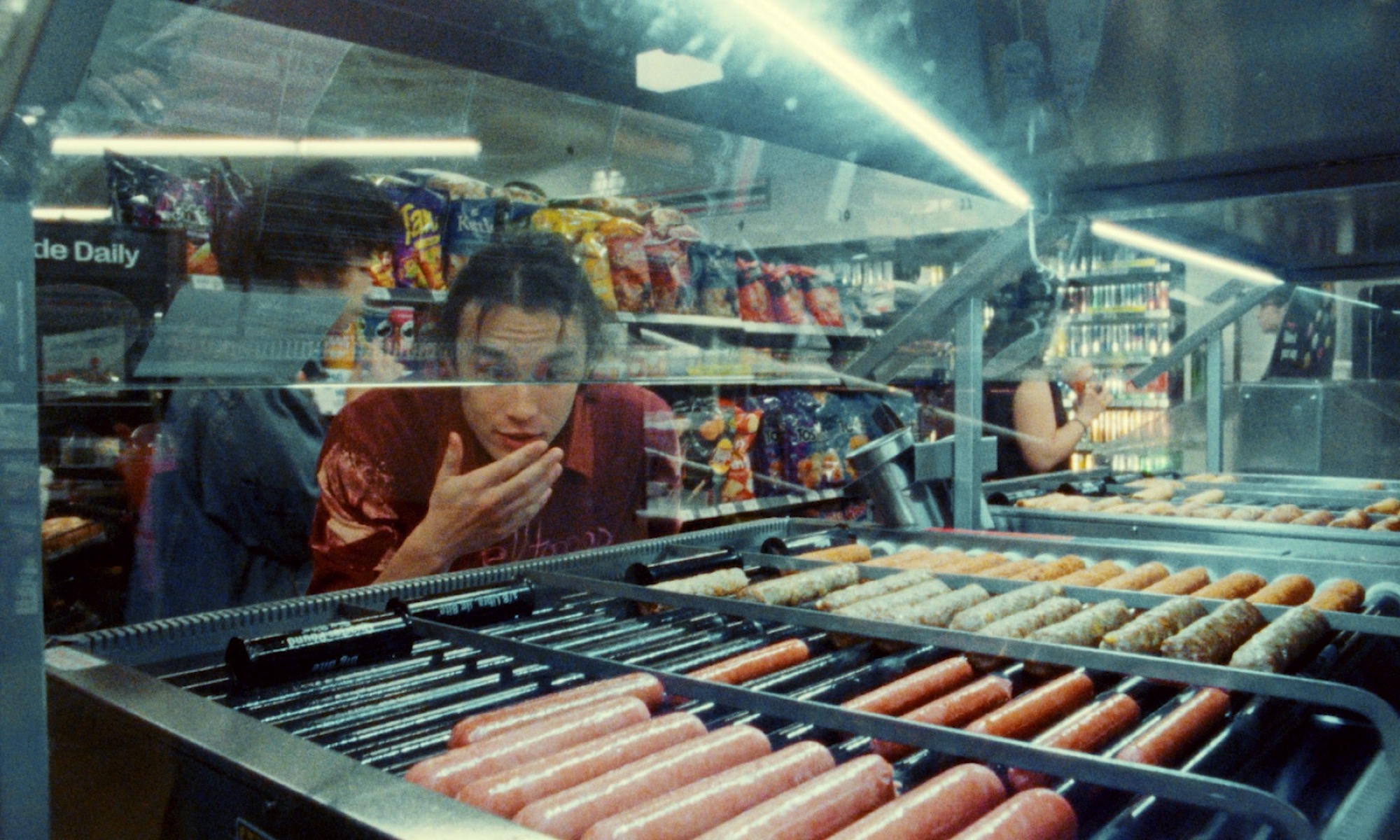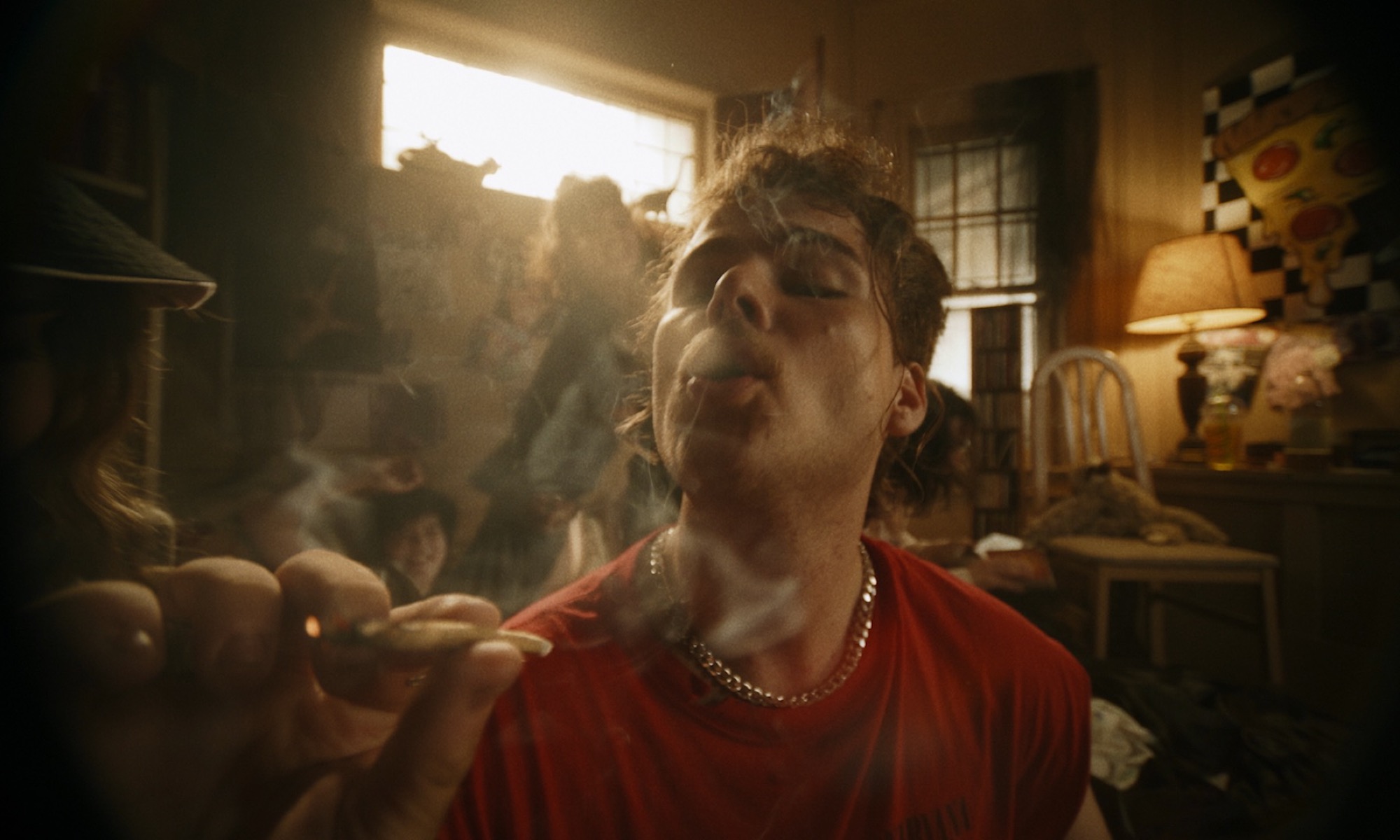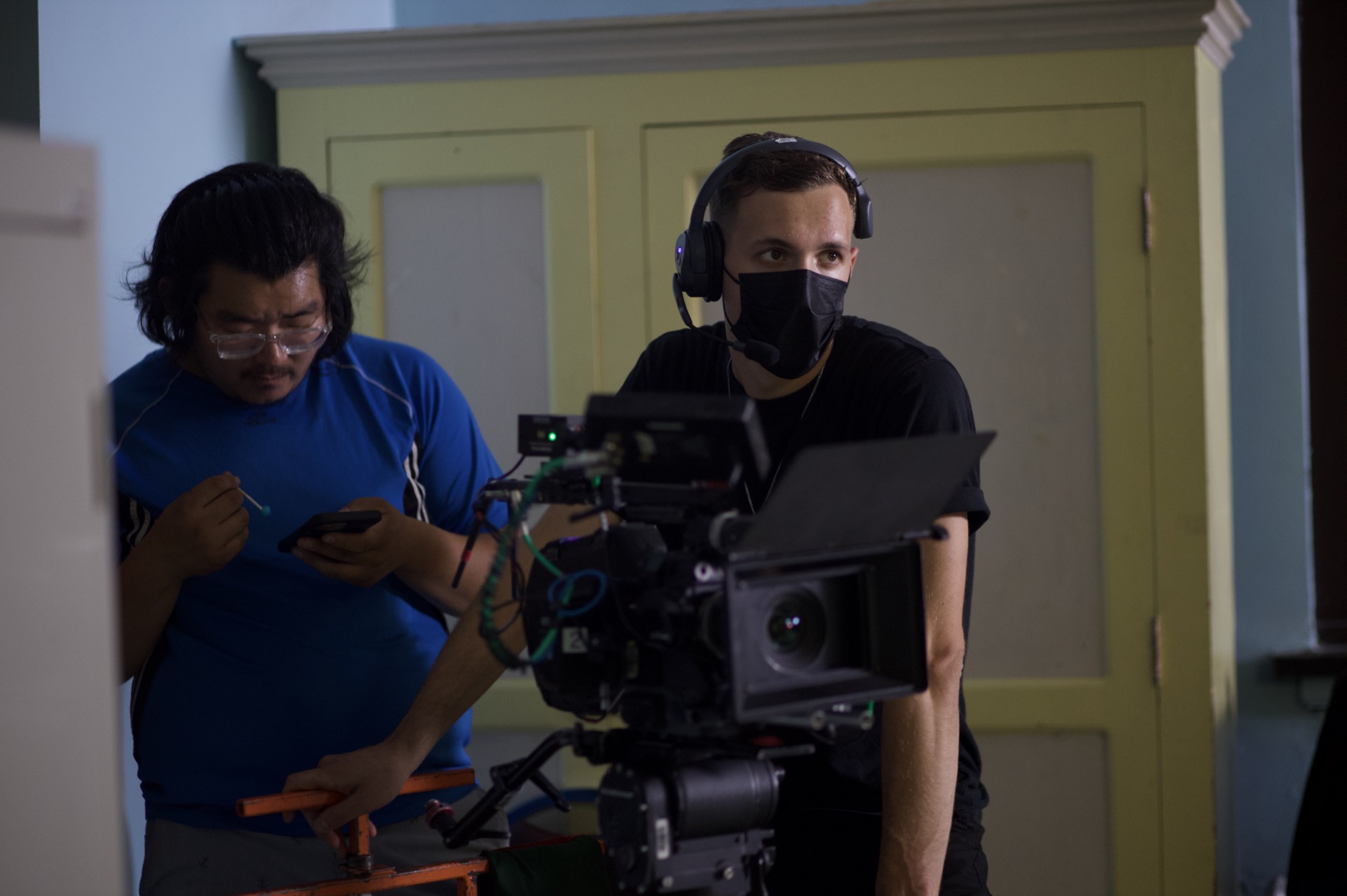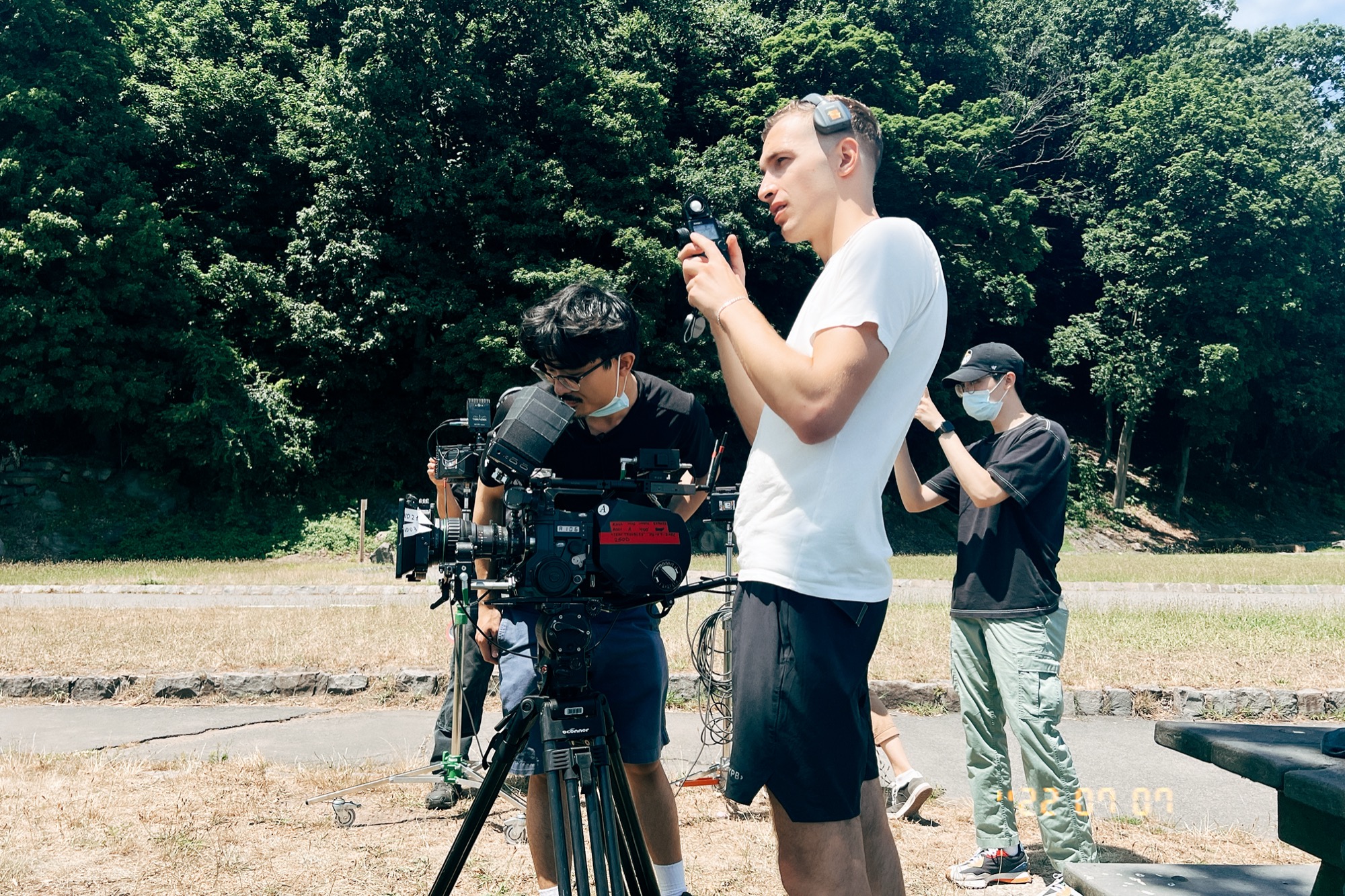
Director Waley Wang, who previously featured on the pages of DN exploring a toxic friendship with his short ,Julie & I, is back with a nostalgic journey of young disaffected angst in Teen Troubles in Dirty Jersey. Working with South Korean indie rock musician The Black Skirts (aka Bryan Cho), the Chinese-American filmmaker has moulded Cho’s key memories of a long lost summer into an ode to youthful spectacles gone by – interlacing documentary-like footage with new music from the musician to go beyond the original visual album brief. Teen Troubles in Dirty Jersey, alongside being a delightful hit of nostalgia, was further brought to life by Wang to explore toxic masculinity and the oddly separate lives of the diaspora Asian community in New Jersey. Filming on 16mm, scouting locations yet to be gentrified and the thrum of punk all come together to create the evocative time warp. We spoke to Wang about how he was able to create a very sure sense of self in each of the film’s six leads, capturing the Jersey of his and The Black Skirt’s youth and evoking memory through his choice of shooting formats.
Teen Troubles in Dirty Jersey is a nostalgic assault of love, loss and youth. How did it all come about?
Bryan from The Black Skirts approached me wanting to make an autobiographical visual album capturing the nostalgia of his memories growing up in New Jersey as a delinquent punk teen with his friend family and fellow townsfolk in the 90s. The idea started as a visual album but we landed on making it a cohesive short film with a script and story. I wrote a first outline, a total creative guessing game that was unusable but helped jog his memories. That really kicked off our video calls which were part casual chatting, part low-key interviews where he’d go into great detail telling me about his experiences in Jersey. We talked extensively about what his friends were like as people and how they ended up later in life, and most importantly, his emotional experience and personal takeaways through all the events.
We both had our teenhoods as diasporic Asian boys in the same parts of Bergen County.
It was a lovely process. Bryan was transparent about two things: first that he wanted me to recreate his adventures to relive them, and second that this is intended as a form of art therapy for him through my eyes. I made it a goal to tell something moral and helpful for viewers of all ages, whether as an evocation and reflection of your 20s for older audiences or a warning about reckless excess in the name of thrilling fulfilment for those still in their 20s or younger watching.
When his album was taking shape and we had a release date and when he had a set idea of which tracks I would use for the project I processed and reflected on the information from our calls and molded them into the basis of my script. We both had our teenhoods as diasporic Asian boys in the same parts of Bergen County, he even took a class at my high school. We went to the same strip malls, same parks by the Hudson, and likely the same diners, so it was pretty easy for me to flesh out a story of his memories through my own experiences, just with a 90s flavor instead of my 00s teenhood.

The film is brimming with so many references through the clothing, music and character portrayals, how did you work to gather together all of the relevant material and then combine it into a coherent representation of Bryan’s memories?
To immerse myself into punk aesthetics and attitude, I watched The Decline of Western Civilization recommended to me by my punk friend Davide Sorasio, SLC Punk! which teen Bryan and his pals loved, FLCL as I love anime, and our only references besides those were Smashing Pumpkins’ 1979 video and the film Christiane F. whose message, and also capturing of youthful freedom before its story took a very dark moral turn, resonated with me.
Furthermore, during research, I came across the heroin chic fashion craze of the 90s and I wanted to destroy its sensibilities and any association of it being a good thing, through implying the damage it caused by its actions via Electra’s arc. I love nostalgia, but I think nostalgia should serve a purpose. In addition to making Bergen County, New Jersey its own character in this film, my goal was to write authentic adventures featuring an Asian character exploring themselves among non-Asians that loved and supported them. That’s something extremely Bergen County for me and what I wanted to capture, along with our shared Americana experiences in New Jersey: our carnivals, vintage diners – which have been shrinking rapidly, 7/11 oases, jamming out in cover bands from Suburban homes, the delinquent and reminiscent shade of summer nights and blinding urban lights mixed with nature.
My goal was to write authentic adventures featuring an Asian character exploring themselves among non-Asians that loved and supported them.
I suspect for diasporic Asians, we live in a somewhat different New Jersey from others, so I wanted to portray how I remembered my county: boatloads of desire from a perpetual search for an American dream shaped by pop entertainment that doesn’t feature us or our sensibilities in the first place. I was inspired by the train in Satyajit Ray’s Aparajito to use the GW bridge as a distant monument symbolizing a small-town sense of unattainability.

Was it intimidating trying to create a film which needed to remain faithful to someone else’s memories?
I definitely put a lot of my personal struggles into the experiences of Bryan’s memories. Such as the idea of what macho punk American masculinity means to a diasporic East Asian boy who may have more fantastical imaginations that could run amok in the freedom of Western excess. During production, it was important for me to cast stylish actors that looked and breathed like Bryan and his real-life friends. All our casting was done by the Elle Jones Casting Company. Our lead Daniel Oliver Lee is a 1st generation Korean American also from right across the water in Jersey. I knew we nailed it when his tape freaked the real-life Bryan and his wife out for how crystal-similar they both looked and sounded. I wanted every character – despite us having six leads – to have a very sure visual sense of self.
I drew a lot from my real-life friends I knew intimately, whose personalities and looks matched Bryan’s stories and old, sparse photos he could find of his friends. I think drawing from people I knew now was important for these recreations of 90s folks to still feel fresh and modern. Atlas (Thomas) Alexander was cast for his physical beauty and ability to lean into near-toxic masculine aggression, Saki Kawamura for her innocent and doe-eyed look as well as ‘feeling’ slightly older like that beach vacation episode of The Wonder Years, Brody Hafen for having Bosko’s inquisitive teddy-bear like energy, Thea Henry for her spacey yet assured soul, and Lennox Hart-Torres for their reserved, parental guidance.
Directing just came from parts of myself that I identified the most with each of these character’s energies, using that as a base point, and also having key props (the camcorder, the toothy stuffed animal, hot dogs) to help work out a few key mental points for the cast to play with, especially during improvised scenes. The 7/11 scene was completely done on the fly with cues and ideas I gave each of my actors. It was really fun.

Your cast are incredible, how were you able to feed them the punk / 90s vibes which they wouldn’t have directly experienced yet embody so well?
A lot of references from the 90s! And I told them the story of each of Bryan’s real-life friends from that period, as well as brief psychoanalyses I developed of them based on people I knew and myself and Bryan’s own psychological profiles he remembered them by. I also cast them based on particular looks. For some scenes we’d blast punk music, and from films like The Decline of Western Civilization, I studied how those bonafide punks talked – I listened to their views on capitalism, authority, sex, and friendships, and conveyed them briefly to the cast. I tried to efficiently boil certain down manners of speaking, attitudes, sense of cool, etc. that felt 90s and steered them to personalities that I felt reflected the period’s soul. The 90s styling by Nina Attal also did a tremendous amount of the work. And I think after having the look and an idea of what those people were like, it all came together by giving them a story from that period where I wanted to convey things such as the free-spirited lies and decay of heroin chic.
I love nostalgia, but I think nostalgia should serve a purpose.






The decision to shoot on film alongside Teen Troubles in Dirty Jersey’s naturalistic, near documentary style definitely adds to the film’s feeling of recollection. How long were you shooting for and what did you augment the 16mm footage with?
My DP Konstantin Lyubimov and I decided to shoot this on 16mm for a palpable, discernible texture and touch as if we had found this footage while heightening its scope. Konstantin really championed shooting on film to elevate the vision of this project. His colorful lighting and mastery of cool, urban, modern color palettes and lighting further made these memories come alive in a gritty and ethereal way, which is how Bryan and I remember Jersey. Our coverage was pretty straightforward so there was a lot of room to grab more. And our PD Sharon Vion loves everything 90s and we worked together before so that part was really intuitive.
It was a five day shoot with a separate extra couple hours of filming inserts. In terms of extra equipment, I also had a Hi8 camcorder from my friend Jon Fordham and I think using that authentic form of home footage combined with 16mm made a really raw and memory-based canvas. We had a RED Komodo for performance / lip sync takes and some lightweight rigging like the hand shots, since those takes would have burned all our film. Our Colorist Maria Carretero matched them to our 16mm. I selected several shots, including our carnival stock footage, that Jon Fordham converted to VHS.

What’s next in the pipeline for you?
Work-wise I just directed the NY Unit of a Christmas campaign commercial for a well-known European airline and a few music videos due this Winter for an electronic/soul artist from Nettwerk I’m creative directing; he’s my age and his parents are also immigrants. Writing for them will kick off when his album’s in a shape he likes. And I just finished post for a fashion video I made with my pal Alexey (2nd Unit DP of the Amazon/Nicole Kidman show Expats).
I’m also writing two personal shorts attached to feature outlines, one is a horror about a telepathic Chinese American woman who lost her visions after morbid traumas as a kid and the other is a coming-of-age comedy drama about my family – the short for that is about a Chinese immigrant Mother and her teenaged Daughter who can’t connect via language, a real generational issue among AAPI communities that we don’t talk about (maybe we’re too embarrassed.) If anybody has a commercial, music video, or fashion video they’d like to consider hiring me for, please let me know!


